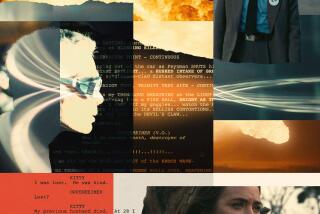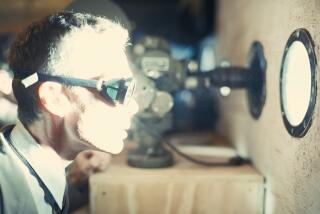Fateful Collisions in ‘Copenhagen’
World events keep conspiring to make Michael Frayn’s “Copenhagen” ever more timely.
A meditation on a real-life meeting between two physicists whose insights helped lay the groundwork for the atomic bomb, Frayn’s story ponders the ways in which people behave like atoms, capable of colliding and setting off chain reactions. The physicists’ reaction--a misunderstanding that explosively self-perpetuates--becomes a symbol of the sort of global discord that currently dominates headlines.
As a stage drama, “Copenhagen” has been a hit in London, New York and Los Angeles. Sunday at 9 p.m., it arrives on television in a PBS presentation adapted and directed by Howard Davies and performed by Stephen Rea, Daniel Craig and Francesca Annis.
The transition between mediums hits a few rough patches but, overall, works fascinatingly well.
Frayn sets his story in the afterlife, as Danish physicist Niels Bohr and his wife, Margrethe, meet with German physicist Werner Heisenberg to try to hash out why Heisenberg paid a visit to the Bohrs in occupied Copenhagen in 1941. Had the meeting turned out differently, Frayn suggests, Nazi Germany might have taken the lead in developing the atomic bomb, and modern history would bear little resemblance to what it does today.
The stage presentation, directed by Michael Blakemore, was set in a celestial lecture hall where the three characters circled one another like atomic particles. Davies’ television version depicts a ghostly meeting in the Bohrs’ now-abandoned home.
Discussion among the ghosts takes place in empty rooms flooded with white sunlight. Re-creations of the 1941 meeting unfold in the house as it was vibrantly furnished back then--a sumptuousness that calls to mind any number of “Masterpiece Theatre” presentations.
The circling movements--the most inspired part of the stage presentation--have been largely abandoned, although the same effect is infrequently achieved by having the camera orbit around each performer.
Through the first half, events unfold with too much of a stately sameness. But patience is rewarded as the presentation builds toward a gripping, artful conclusion.
Rea’s Bohr keeps his guest at arm’s length, wary of this protege who ended up on the other side of a war.
Craig’s Heisenberg, meanwhile, cautiously and courteously tries to explain himself. Annis’ Margrethe is the viewer’s sharp-eyed surrogate, offering running commentary.
Produced by KCET/Hollywood and the BBC, “Copenhagen” gives viewers a lot to think about. Frayn’s characters embody Heisenberg’s uncertainty principle, demonstrating that people, like atomic particles, are essentially unquantifiable, unknowable. Yet only by continually trying to bridge that gap can humankind hope to avoid a catastrophe of mushroom-cloud proportions.
*
“Copenhagen” will be presented Sunday at 9 p.m. on KCET and KVCR. The network has rated it TV-PG (may be unsuitable for younger children).
More to Read
The complete guide to home viewing
Get Screen Gab for everything about the TV shows and streaming movies everyone’s talking about.
You may occasionally receive promotional content from the Los Angeles Times.







